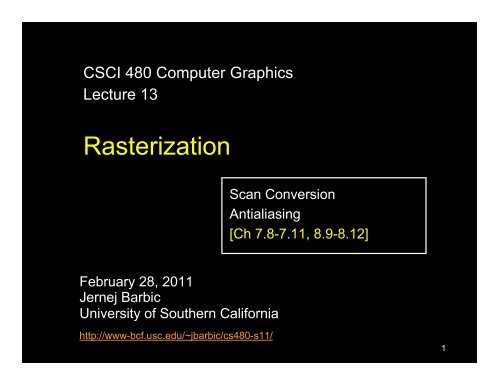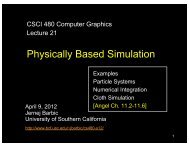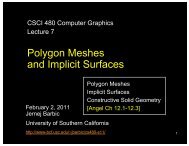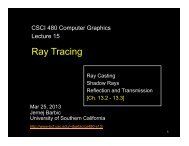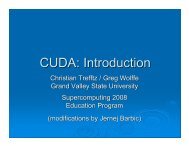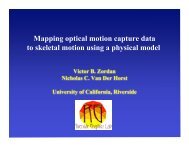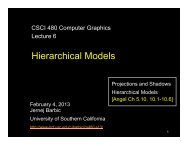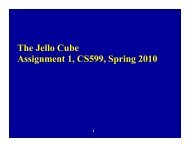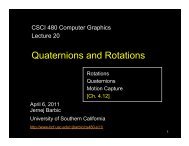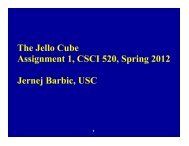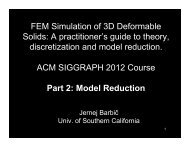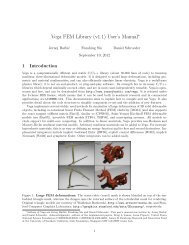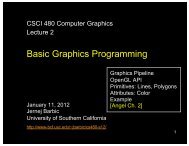Rasterization - University of Southern California
Rasterization - University of Southern California
Rasterization - University of Southern California
You also want an ePaper? Increase the reach of your titles
YUMPU automatically turns print PDFs into web optimized ePapers that Google loves.
CSCI 480 Computer Graphics<br />
Lecture 13<br />
<strong>Rasterization</strong><br />
February 28, 2011<br />
Jernej Barbic<br />
<strong>University</strong> <strong>of</strong> <strong>Southern</strong> <strong>California</strong><br />
http://www-bcf.usc.edu/~jbarbic/cs480-s11/<br />
Scan Conversion<br />
Antialiasing<br />
[Ch 7.8-7.11, 8.9-8.12]<br />
1
<strong>Rasterization</strong> (scan conversion)<br />
• Final step in pipeline: rasterization<br />
• From screen coordinates (float) to<br />
pixels (int)<br />
• Writing pixels into frame buffer<br />
• Separate buffers:<br />
– depth (z-buffer),<br />
– display (frame buffer),<br />
– shadows (stencil buffer),<br />
– blending (accumulation buffer)<br />
2
Rasterizing a line<br />
3
Digital Differential Analyzer (DDA)<br />
• Represent line as<br />
• Then, if Δx = 1 pixel,<br />
we have Δy = m Δx = m<br />
4
Digital Differential Analyzer<br />
• Assume write_pixel(int x, int y, int value)<br />
for (i = x1; i
Digital Differential Analyzer (DDA)<br />
• Assume 0 ≤ m ≤ 1<br />
• Exploit symmetry<br />
• Distinguish special<br />
cases<br />
But still requires<br />
floating point additions!<br />
6
Bresenham’s Algorithm I<br />
• Eliminate floating point addition from DDA<br />
• Assume again 0 ≤ m ≤ 1<br />
• Assume pixel centers halfway between integers<br />
7
Bresenham’s Algorithm II<br />
• Decision variable a – b<br />
– If a – b > 0 choose lower pixel<br />
– If a – b ≤ 0 choose higher pixel<br />
• Goal: avoid explicit computation <strong>of</strong> a – b<br />
• Step 1: re-scale d = (x 2 – x 1)(a – b) = Δx(a – b)<br />
• d is always integer<br />
8
Bresenham’s Algorithm III<br />
• Compute d at step k +1 from d at step k!<br />
• Case: j did not change (d k > 0)<br />
– a decreases by m, b increases by m<br />
– (a – b) decreases by 2m = 2(Δy/Δx)<br />
– Δx(a-b) decreases by 2Δy<br />
9
Bresenham’s Algorithm IV<br />
• Case: j did change (d k ≤ 0)<br />
– a decreases by m-1, b increases by m-1<br />
– (a – b) decreases by 2m – 2 = 2(Δy/Δx – 1)<br />
– Δx(a-b) decreases by 2(Δy - Δx)<br />
10
Bresenham’s Algorithm V<br />
• So d k+1 = d k – 2Δy if d k > 0<br />
• And d k+1 = d k – 2(Δy – Δx) if d k ≤ 0<br />
• Final (efficient) implementation:<br />
void draw_line(int x1, int y1, int x2, int y2) {<br />
int x, y = y0;<br />
int dx = 2*(x2-x1), dy = 2*(y2-y1);<br />
int dydx = dy-dx, D = (dy-dx)/2;<br />
}<br />
for (x = x1 ; x 0) D -= dy;<br />
else {y++; D -= dydx;}<br />
}<br />
11
Bresenham’s Algorithm VI<br />
• Need different cases to handle m > 1<br />
• Highly efficient<br />
• Easy to implement in hardware and s<strong>of</strong>tware<br />
• Widely used<br />
12
Outline<br />
• Scan Conversion for Lines<br />
• Scan Conversion for Polygons<br />
• Antialiasing<br />
13
Scan Conversion <strong>of</strong> Polygons<br />
• Multiple tasks:<br />
– Filling polygon (inside/outside)<br />
– Pixel shading (color interpolation)<br />
– Blending (accumulation, not just writing)<br />
– Depth values (z-buffer hidden-surface removal)<br />
– Texture coordinate interpolation (texture mapping)<br />
• Hardware efficiency is critical<br />
• Many algorithms for filling (inside/outside)<br />
• Much fewer that handle all tasks well<br />
14
Filling Convex Polygons<br />
• Find top and bottom vertices<br />
• List edges along left and right sides<br />
• For each scan line from bottom to top<br />
– Find left and right endpoints <strong>of</strong> span, xl and xr<br />
– Fill pixels between xl and xr<br />
– Can use Bresenham’s alg. to update xl and xr<br />
xl xr<br />
15
Concave Polygons: Odd-Even Test<br />
• Approach 1: odd-even test<br />
• For each scan line<br />
– Find all scan line/polygon intersections<br />
– Sort them left to right<br />
– Fill the interior spans between intersections<br />
• Parity rule: inside after<br />
an odd number <strong>of</strong><br />
crossings<br />
16
Edge vs Scan Line Intersections<br />
• Brute force: calculate intersections explicitly<br />
• Incremental method (Bresenham’s algorithm)<br />
• Caching intersection information<br />
– Edge table with edges sorted by y min<br />
– Active edges, sorted by x-intersection, left to right<br />
• Process image from<br />
smallest y min up<br />
17
Concave Polygons: Tessellation<br />
• Approach 2: divide non-convex, non-flat, or<br />
non-simple polygons into triangles<br />
• OpenGL specification<br />
– Need accept only simple, flat, convex polygons<br />
– Tessellate explicitly with tessellator objects<br />
– Implicitly if you are lucky<br />
• Most modern GPUs scan-convert only triangles<br />
18
Flood Fill<br />
• Draw outline <strong>of</strong> polygon<br />
• Pick color seed<br />
• Color surrounding pixels and recurse<br />
• Must be able to test boundary and duplication<br />
• More appropriate for drawing than rendering<br />
19
Outline<br />
• Scan Conversion for Lines<br />
• Scan Conversion for Polygons<br />
• Antialiasing<br />
20
Aliasing<br />
• Artifacts created during scan conversion<br />
• Inevitable (going from<br />
continuous to discrete)<br />
• Aliasing (name from<br />
digital signal processing):<br />
we sample a continues<br />
image at grid points<br />
• Effect<br />
– Jagged edges<br />
– Moire patterns<br />
Moire pattern from<br />
sandlotscience.com<br />
21
More Aliasing<br />
22
Antialiasing for Line Segments<br />
• Use area averaging at boundary<br />
• (c) is aliased, magnified<br />
• (d) is antialiased, magnified<br />
• Warning: these images are sampled on screen!<br />
23
Antialiasing by Supersampling<br />
• Mostly for <strong>of</strong>f-line rendering<br />
(e.g., ray tracing)<br />
• Render, say, 3x3 grid <strong>of</strong> mini-pixels<br />
• Average results using a filter<br />
• Can be done adaptively<br />
– Stop if colors are similar<br />
– Subdivide at discontinuities<br />
one<br />
pixel<br />
24
Supersampling Example<br />
• Other improvements<br />
– Stochastic sampling (avoiding repetition)<br />
– Jittering (perturb a regular grid)<br />
25
Temporal Aliasing<br />
• Sampling rate is frame rate (30 Hz for video)<br />
• Example: spokes <strong>of</strong> wagon wheel in movie<br />
• Possible to supersample and average<br />
• Fast-moving objects<br />
are blurred<br />
• Happens automatically<br />
with real hardware (photo<br />
and video cameras)<br />
– Exposure time (shutter speed)<br />
– Memory persistence<br />
(video camera)<br />
– Effect is motion blur<br />
Motion blur<br />
26
Wagon Wheel Effect<br />
Source: YouTube<br />
27
Motion Blur Example<br />
Achieve by<br />
stochastic<br />
sampling in<br />
time<br />
T. Porter, Pixar, 1984<br />
16 samples / pixel / timestep<br />
28
Summary<br />
• Scan Conversion for Polygons<br />
– Basic scan line algorithm<br />
– Convex vs concave<br />
– Odd-even rules, tessellation<br />
• Antialiasing (spatial and temporal)<br />
– Area averaging<br />
– Supersampling<br />
– Stochastic sampling<br />
29


